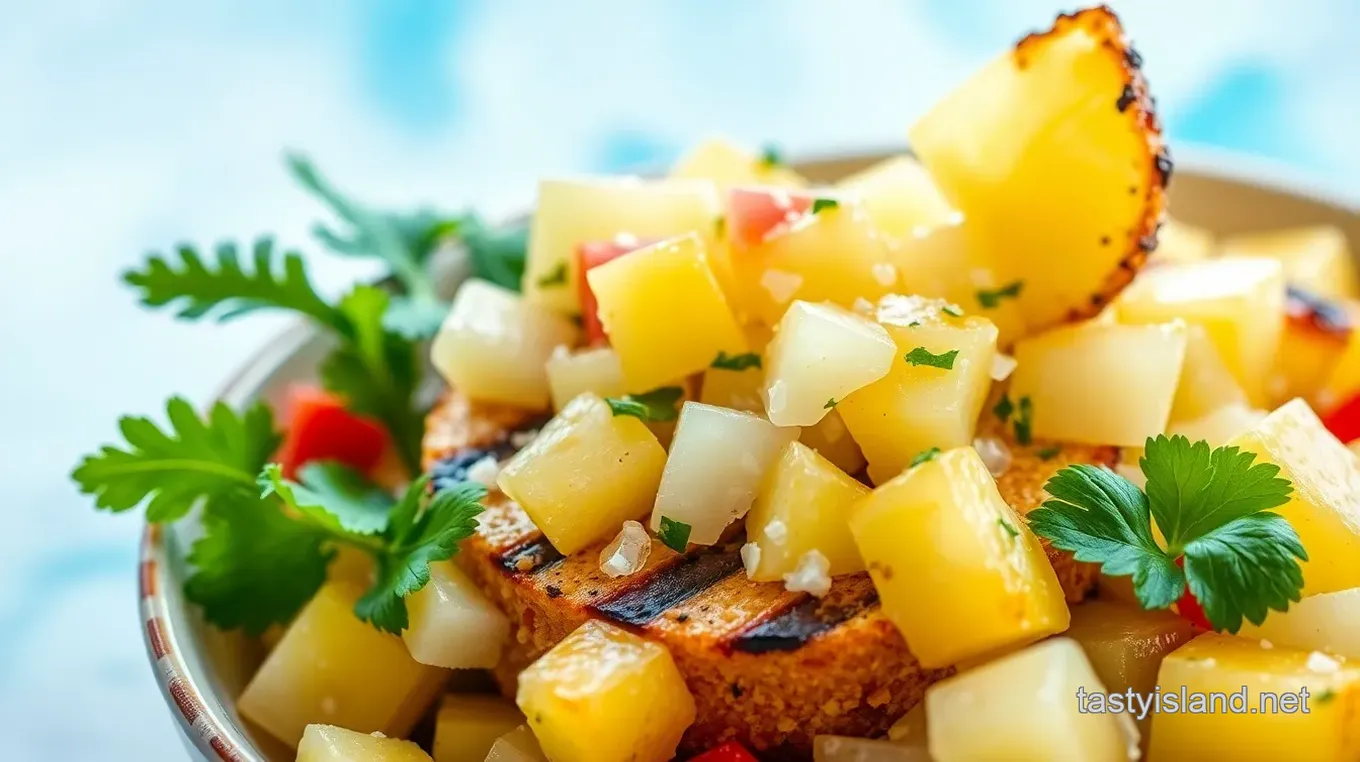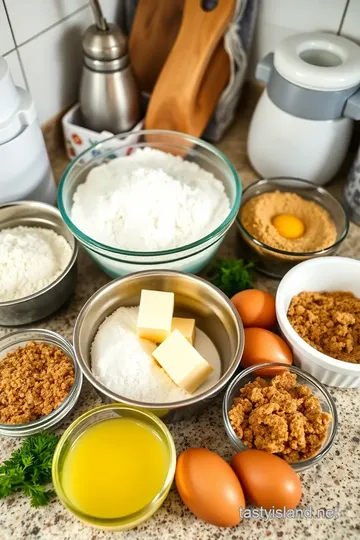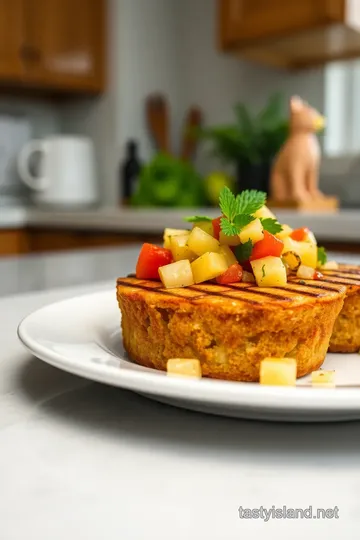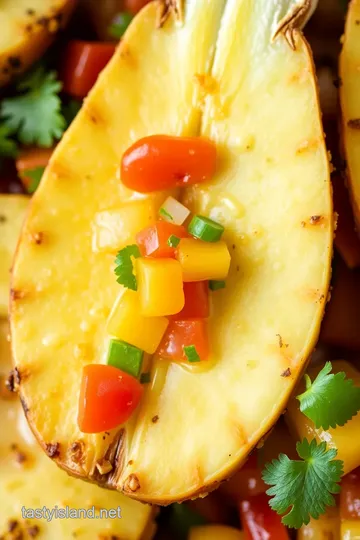Grilled Pineapple Fresh Salsa Delight
Discover my Grilled Pineapple Fresh Salsa Delight, a vibrant twist for summer BBQs! Perfect with grilled meats or as a zesty chip dip. Let's savor those tropical flavors together!

- Recipe Overview
- Key Benefits
- Essential Ingredients Guide: Unlocking Flavor with Fresh Ingredients
- Unlocking the Secrets of Professional Cooking Methods
- Pro Tips & Secrets
- Perfect Presentation
- Storage & Make-Ahead
- Creative Variations
- Complete Nutrition Guide
- Expert FAQ Solutions
- Encouraging Conclusion
- Recipe Card
You know that moment when the aroma of something delicious hits your nose, and you're instantly transported back in time? for me, it’s the scent of grilled pineapple wafting through the air after a summer bbq.
It's like being wrapped in a warm hug from the past, reminding me of family gatherings, laughter, and all those backyard cookouts.
So, let's talk about a flavor bomb that’ll take you straight to tropical vibes: grill pineapple fresh salsa delight .
Imagine sweet, smoky grilled pineapple, juicy bell peppers, and zesty lime intertwining to create a burst of flavor that’ll make your taste buds dance; this isn’t just any salsa—we’re stepping it up a notch!
Recipe Overview
This salsa does more than taste delectable; it has roots in latin american cuisine , where bold flavors and fresh ingredients reign supreme.
Picture this: sweet pineapple, perhaps originating from the caribbean, meets vibrant veggies in a dance of textures and tastes. it’s a party in a bowl that’s perfect for any summer bbq .
With just about 55 minutes of your time (15 for prep and 10 for grillin’!), you can whip up this easy salsa that serves about 4-6 people .
Seriously, it's as simple as chopping, grilling, and mixing—a total breeze! and the cost? you can make pineapple salsa with cilantro without breaking the bank.
Quality fresh ingredients are the key, making it a pretty budget-friendly treat.
Key Benefits
But wait, there’s more! let’s chat health benefits. pineapple isn’t just delicious; it's packed with nutrients and is rich in vitamin c, making our grilled pineapple fresh salsa delight a nutritious salsa option .
With every bite, you're not just getting flavor; you're treating your body right. plus, it’s gluten-free and a fantastic low-calorie dip, so you can munch guilt-free while you catch up with friends.
This salsa isn’t just for munching on chips; it shines as a topping for grilled meats , adds a zing to grilled pineapple tacos , or makes an ideal choice for fiesta party food ideas .
Think about serving it at your next gathering—it fits perfectly in the lineup of summer bbq ideas , especially paired with a zesty salsa for grilled meats.
What's more, it’s a hit at special occasions! whether it’s taco tuesday or an outdoor get-together, everyone loves a fresh, bright option on the table.
You can elevate your summer cookouts with a grilled fruit salsa that’s both sweet and savory. just speaking about those flavors is making my mouth water!
Salsa variations are endless, too. Feel free to mix in other fruits like mango or peach for extra sweetness, or toss in black beans for added depth and protein. Talk about versatile!
Alright, now that we’ve gotten the emotional draw of flavors and the health perks out of the way, let’s head into the fun—getting your ingredients ready.
Trust me, your guests will be thanking you for this salsa, so grab that pineapple and let’s get cooking!

Essential Ingredients Guide: Unlocking Flavor with Fresh Ingredients
So, let’s dive into the essentials of creating grilled pineapple fresh salsa delight . this refreshing salsa is perfect for those summer bbqs and fits right into our beautiful world of tropical delights.
We all want that burst of flavor, right? well, it starts with knowing your premium core ingredients .
Premium Core Components
First up, let’s talk about detailed measurements . for this salsa recipe, you’ll need one medium ripe pineapple (about 3-4 cups diced ).
Now, if you’re not a fan of measuring in cups, go ahead and weigh that pineapple—around 1.5 kilograms . choose a pineapple that's golden and fragrant for that sweet kick.
When you look for quality indicators, check the skin. it should be firm with a bit of give when you press it.
Dull skin? nah, that’s a no-go. storing your pineapple is simple—keep it at room temperature until it's cut. after slicing, it’s best wrapped in plastic and stored in the fridge, where it’ll last about 3-4 days .
Now, freshness tips : Choose pineapples with bright greens on top. If those leaves are wilting, your pineapple might be on the edge of its prime.
Signature Seasoning Blend
Now, we jump into the signature seasoning blend . a huge part of what makes our fresh salsa recipe pop are the spices and herbs.
For your salsa, grab jalapeño peppers, red onions, and fresh cilantro . want to kick things up a notch? grab some garlic salt—just a pinch can elevate the flavors like nobody's business!
Culinary expert advice here: herb pairings like cilantro and lime juice take your salsa from good to to-die-for . you might even explore regional variations like mango or peach mixed in for a sweet twist.
It’s all about putting a little personal flair into those easy salsa recipes .
Smart Substitutions
What happens when you’re running low on ingredients? no sweat! there are always smart substitutions . if you’re out of fresh pineapple, canned pineapple works for a quick fix.
For dietary modifications, let's say you’re vegan or gluten-free—this salsa already fits that bill! want crunch? toss in some bell peppers or even avocado for that creamy texture.
Emergencies happen, right? if you can’t find lime juice, lemon juice will do in a pinch. and during those winter months when fresh ingredients aren’t in abundance, go for some frozen pineapple —just let it thaw before mixing.
Kitchen Equipment Essentials
Now, let's chat kitchen equipment essentials . dishing out this tropical salsa doesn't need a truckload of fancy tools. you just need a good sharp knife , a cutting board , and a grill (charcoal or gas).
Don’t have a grill basket? use skewers for your pineapple. it’s a game changer for those grilled fruit salsas !
Storing is key, too! keep your salsa in a glass container with a lid . this helps maintain freshness—especially important if you want to whip up some sweet and savory dips for leftovers.
Creating bliss in the kitchen shouldn't feel complicated. think of it like a fun experiment! this recipe will undoubtedly elevate your summer parties and serve as a zesty salsa for your grilled meats .
Ready, Set, Salsa!
Alright, we’re now totally prepped. armed with the right ingredients and tips, you’re ready to tackle this grilled pineapple fresh salsa delight .
Can you taste the summery goodness already? now, let’s get into the juicy part: the instructions on how to whip this beauty up! grab your ingredients and let’s salsa it up!
Unlocking the Secrets of Professional Cooking Methods
Alright, let’s dive into the art of cooking! whether you're just starting out or looking to sharpen your skills, understanding professional cooking methods is the way to go.
One of my favorite things about cooking is how it brings people together, like at a summer bbq, where easy salsa recipes like grilled pineapple fresh salsa delight can steal the show.
Trust me, everyone will be raving about that tropical salsa!
Essential Preparation Steps
Before you even think about lighting that grill, let’s get organized. you’ve probably heard the fancy term mise en place – it just means having everything in its place.
Picture this: all your ingredients chopped, diced, and prepped before you start cooking. it makes the process smoother and way less stressful.
Now, onto time management . if you've ever tried to juggle chopping tomatoes while waiting for the grill to heat up, you know how chaotic it can be.
A tip? set a timer for each step. for example, while your pineapple is on the grill for about 4- 5 minutes per side , you can use that time to prepare your other ingredients.
And speaking of organization, can i just say how important it is to keep your workspace tidy? nothing drives me crazier than searching for the cutting board cramped under a mountain of ingredients.
A clean space means you're less likely to mess up!
Safety first, folks! Always remember to use a temperature gauge. For grilled pineapple, the ideal grill temperature is around 400° F . Trust me, your taste buds will thank you.
Step-by-Step Process
Let’s break it down. Here’s a simple way to whip up that Grilled Pineapple Fresh Salsa Delight :
- Prepare Your Ingredients : Start by peeling and coring about 1 medium ripe pineapple – you want about 3-4 cups diced . Cut it into rings or chunks.
- Get the Grill Going : Preheat your grill to that magic medium-high heat .
- Grill That Pineapple : Lightly oil your grill grates, then pop the pineapple on. Grill for about 4- 5 minutes per side until you see those beautiful grill marks.
- Chop and Dice : While your pineapple is grilling, get to work on your other ingredients. Dice a bell pepper, chop a red onion, and seed and mince your jalapeños.
- Combine and Chill : Once the pineapple is done, let it cool a bit, then chop it into chunks and mix it all together in a bowl with your veggies and a handful of fresh cilantro.
- Dress for Success : Squeeze the juice of 2 limes over your salsa and add salt to taste. Give it a good mix and let it chill in the fridge for about 30 minutes to meld those flavors.
Expert Techniques
Now, let’s get fancy. if you want to elevate your salsa game, consider adding quality checkpoints . when grilling, make sure to watch the pineapple closely.
If you let it go too long, it can turn to mush. you want it caramelized but still firm!
Troubleshoot any issues like blandness by adjusting the lime juice or even adding a touch of honey for that sweet twist.
Experiment with those salsa variations ! ever tried adding diced mango? it’s a game-changer!
Success Strategies
Avoiding common mistakes can save you time and heartbreak. one classic mishap is overcooking the pineapple – trust me, you want it slightly crisp.
And don’t skip the chilling step! salsa is always better after flavors mingle in the fridge.
Looking to make things ahead? many elements work beautifully as make-ahead options. chop up your salsa ingredients earlier in the day and grill the pineapple when you’re ready to serve.
It’s perfect for summer bbqs or fiesta party food ideas!
Wrapping it Up
Cooking can be such a rewarding experience, especially when you get to share dishes like this grilled pineapple fresh salsa delight with friends and family.
It embodies everything great about summer – fresh ingredients and bold flavors that remind us to slow down and enjoy meals together.
And there you have it! a fun, easy way to impress everyone at your next gathering with vibrant hues and tropical tastes.
Want to know more about grilling techniques or dive deeper into some sweet and spicy salsa recipes? let's explore some additional information!

Pro Tips & Secrets
Let’s kick things off with my pro tips for making your grilled pineapple fresh salsa delight truly shine. first, let me just say, grilling pineapple is a game-changer.
It brings out those sweet flavors in a way that’s just magical. for the best caramelization on those pineapple slices, make sure your grill is piping hot before you toss them on.
We’re talking about medium-high heat here, folks!
Another nice trick? save some time by prepping your salsa ingredients while the pineapple is grilling. chop that red onion and dice your jalapeños so you’re ready to mix it all together when the pineapple cools a bit.
And don’t skimp on the lime juice! it brings life to your salsa like you wouldn’t believe—think of it as the cherry on top, except it’s a zesty punch that will have everyone coming back for more.
Perfect Presentation
Now, if you want to wow your guests, let’s chat presentation . when plating your tropical salsa , think color. mix those bright yellows and greens with vibrant red from your bell peppers.
A little sprinkle of extra cilantro on top can really make the colors pop!
Garnish is key, too! consider pairing your salsa with tortilla chips in a cute little basket or serving it directly in a hollowed-out pineapple for that tropical flair.
Everyone will be snapping pics for their socials, trust me! how’s that for a cool summer bbq idea? bonus points if you drizzle a bit of lime juice over the top.
Storage & Make-Ahead
Alright, let’s get real about storage . your pineapple salsa can chill in the fridge for up to three days . just make sure to keep it in a sealed container to preserve that fresh taste.
Honestly, i love making this salsa ahead of time for gatherings. it gives the flavors time to meld, making it even tastier!
When it comes to reheating, there’s really no need—this salsa is best served cold! if you want to switch things up, try adding some freshly diced avocado when serving for a creamier texture.
Just remember, avocado doesn’t hold up well in the fridge, so add it right before you're ready to impress your guests!
Creative Variations
Here’s where the fun really begins— creative variations of your salsa! maybe you’re feeling adventurous? toss in some diced mango for that sweet twist or black beans for added protein.
You could also switch it up seasonally with fresh peaches or vibrant summer tomatoes.
And for those with dietary restrictions, no worries! this salsa is totally vegan and gluten-free . just grab those fresh ingredients and go wild.
Want to give it a kick? try adding some diced bell peppers for that sweet and spicy mix. the sky's the limit!
Complete Nutrition Guide
Let’s break down the nutrition for our grilled pineapple fresh salsa delight. with about 80 calories per serving, it’s a guilt-free addition to your plate.
Plus, did you know pineapple has tons of vitamin c? that means this salsa is not just tasty but also a healthy choice, giving you a refreshing boost for those sunny summer days.
And keep in mind, you can easily adjust the recipe to fit your dietary needs! use less jalapeño for a milder salsa, or add more cilantro for an herbaceous punch.
Whatever floats your boat!
Expert FAQ Solutions
Lastly, let’s tackle some frequent questions . “What if my salsa seems too runny?” No problem! Just add a little more diced bell pepper, which will absorb excess juices without losing flavor.
“Do I have to grill the pineapple?” Honestly, you don’t, but grilled pineapple has this smoky char that really elevates the taste, so try it if you can! And what about leftovers? Trust me, they won’t last long because everyone will want more of that sweet and savory dip !
Encouraging Conclusion
So there you have it! making this grilled pineapple fresh salsa delight is a breeze, and you’ll definitely impress your friends or family at your next gathering.
With easy prep and a burst of tropical flavors, how could you not love it? don't be afraid to experiment with your salsa variations , and make it your own.
It’ll be the hit of any bbq or fiesta party!
Now, it’s time to fire up that grill and get going. Happy cooking!

Grilled Pineapple Fresh Salsa Delight Card

⚖️ Ingredients:
- 1 medium ripe pineapple (about 3-4 cups diced)
- 1 medium red bell pepper, finely diced (about 1 cup)
- 1 small red onion, finely chopped (about 1/2 cup)
- 1-2 jalapeño peppers, seeded and minced (to taste)
- 1/4 cup fresh cilantro, chopped
- Juice of 2 limes (about 1/4 cup)
- Salt, to taste
🥄 Instructions:
- Step 1: Prepare the Pineapple: Peel and core the pineapple, then cut into rings or chunks. Preheat the grill to medium-high heat.
- Step 2: Grill the Pineapple: Lightly oil the grill grates and place the pineapple on the grill. Grill for about 4-5 minutes per side or until grill marks appear and the fruit caramelizes.
- Step 3: Chop Other Ingredients: While pineapple is grilling, finely dice the red bell pepper, red onion, and jalapeño peppers. Chop cilantro and set aside.
- Step 4: Combine Ingredients: Remove grilled pineapple and let it cool slightly. Dice the grilled pineapple and add it to a mixing bowl with bell pepper, onion, jalapeño, and cilantro.
- Step 5: Dress the Salsa: Squeeze lime juice over the mixture, season with salt to taste. Mix until well combined.
- Step 6: Chill and Serve: Allow the salsa to chill in the refrigerator for at least 30 minutes for flavors to meld. Serve chilled as a topping or dip.
Previous Recipe: Ultimate Roast Baby Potatoes with Garlic & Herbs: 5 Delicious Tips!
Next Recipe: Delicious Spicy Szechuan Noodles: My Quick & Tasty 15-Minute Dish
